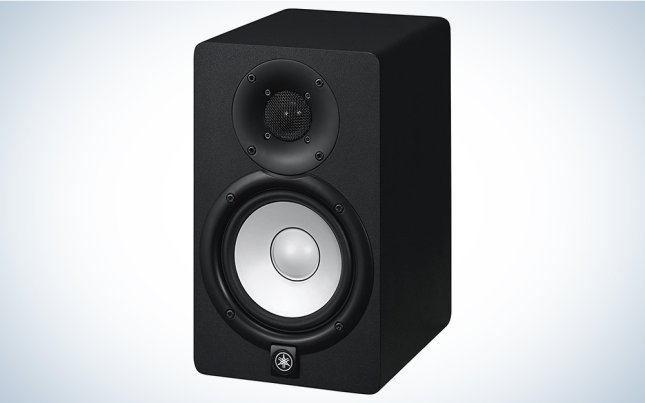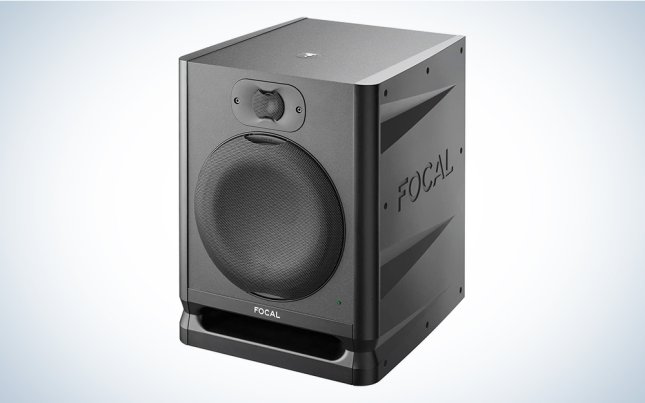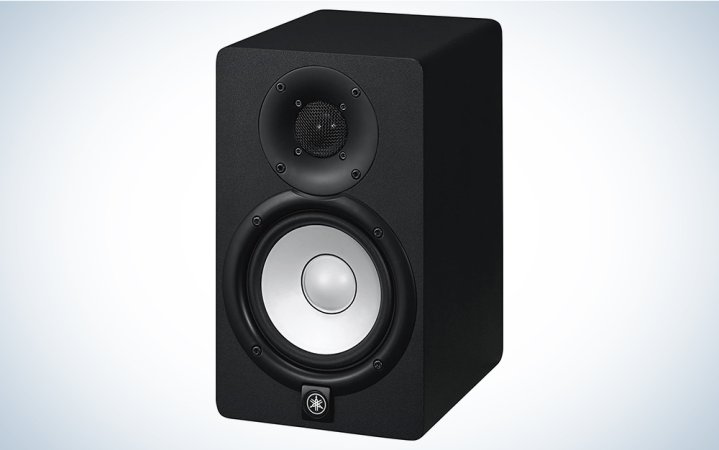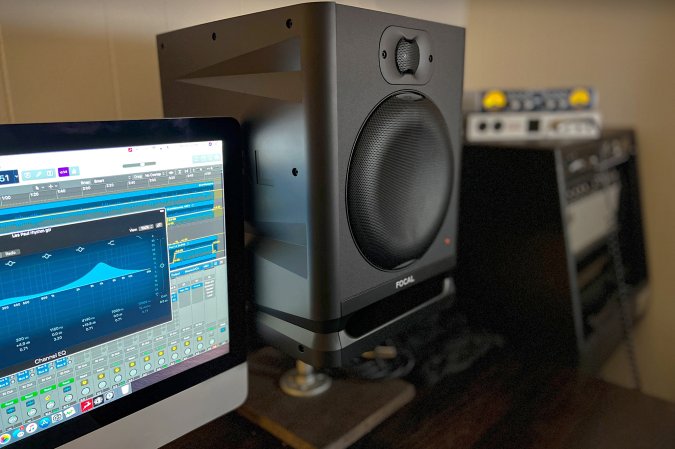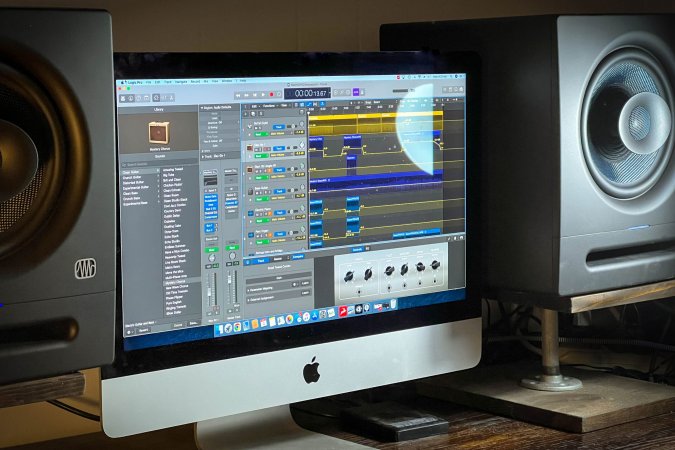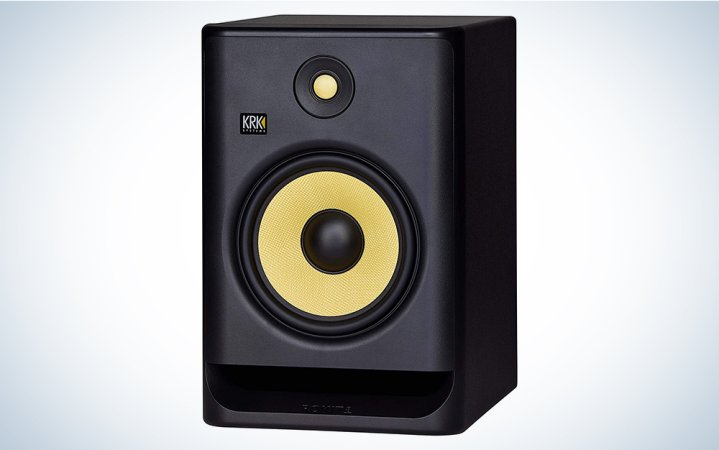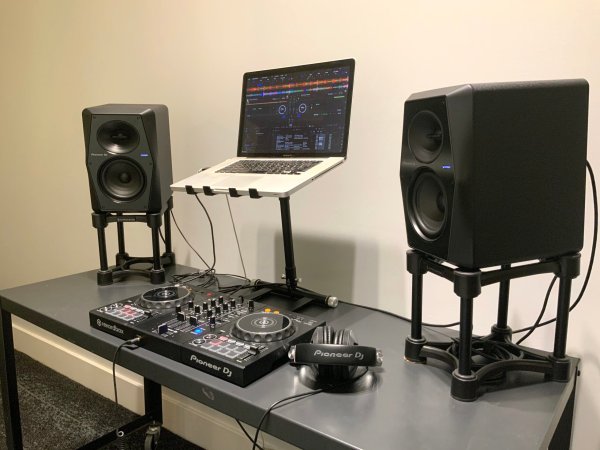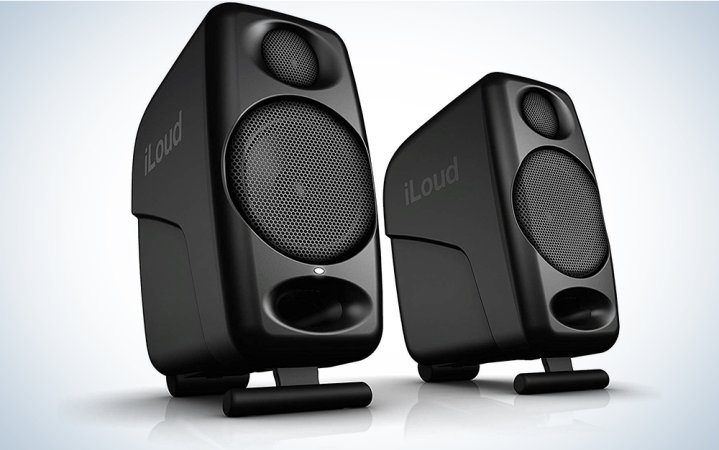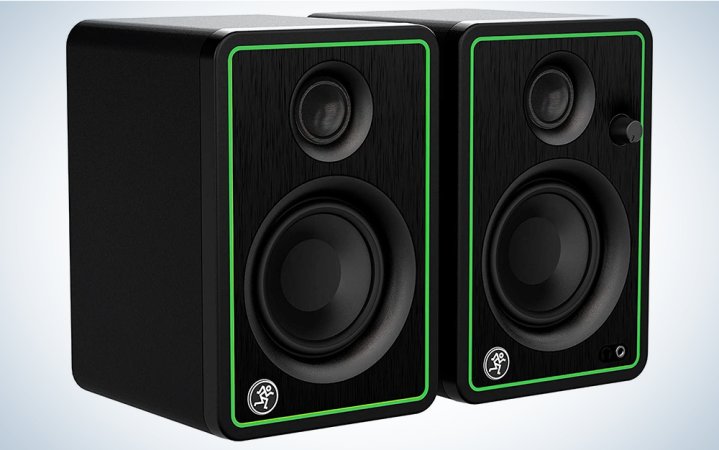We may earn revenue from the products available on this page and participate in affiliate programs. Learn more ›
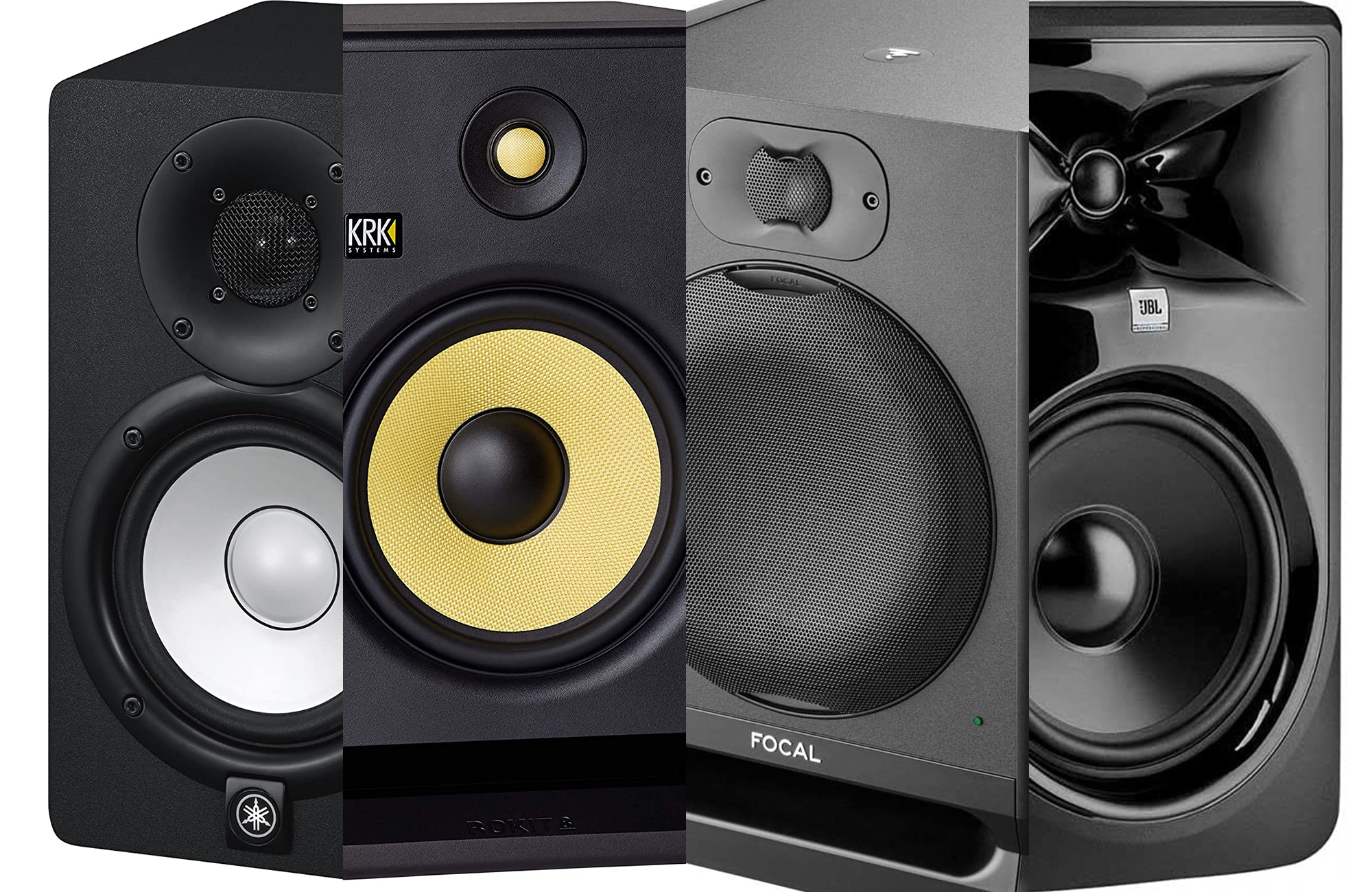
It’s a common scenario: You’ve spent endless hours in front of your studio monitors, painstakingly polishing your sonic masterpiece to perfection. But then, when you play that finished product away from your home workstation—on speakers in another room, on your car stereo, on headphones—it suddenly sounds very different. Maybe it’s shrill, boomy, or you can barely pick out the lead vocal. No, you’re not imagining things, but you might be surprised to learn that the problem is probably due to mixing on inaccurate speakers. That’s why you should upgrade your studio monitors. Unlike hi-fi speakers, which tend to “flatter” sound by enhancing lows and highs to provide a pleasing listening experience, the best studio monitors are designed to reproduce sound exactly as intended—warts and all—so you can make informed decisions about your mix without being influenced by sonically hyped speakers.
It’s the audio equivalent of viewing the world through a clear window versus stained glass: Stained glass creates gorgeous colors and patterns, but sometimes you just need to see what’s on the other side, even if it’s ugly out there. Let’s peer at some top choices to bring this clarity home.
- Best overall: Yamaha HS5
- Best for golden ears: Focal Alpha 80 Evo
- Best for an affordable Atmos setup: PreSonus Eris Pro 8
- Best for electronic producers: KRK ROKIT 8
- Best for DJs: Pioneer DJ VM-50
- Best for home recording studios: JBL LSR 305P MKII
- Best portable: IK Multimedia iLoud Micro Monitors
- Best budget: Mackie CR3-X
How we selected the best studio monitors
With hundreds of choices, we focused on the best studio monitors that balance proven performance, value, and universal appeal. All the brands here make a wide range of professional recording products; you’ll find their production tools in just about every recording studio. The monitors we profile here represent the culmination of decades of audio research and testing—a combination of personal experience, peer recommendations, critical reviews, and user impressions. They’ve been established in the market for years, have earned the stamp of approval from pros we’ve consulted, and we like them, too.
The best studio monitors: Reviews & Recommendations
Wading through the options can be daunting. We’ve made it a little easier with our favorite picks for various content creators, from podcasters to EDM producers to mixers on the go. Our choices are self-powered studio monitors, meaning you won’t need a separate amplifier (though you may still need speaker wire). With models starting at $99, there are bound to be monitor speakers that fit your budget. Oh, and it’s important to note that pro studio speakers are often sold as singles, so don’t forget to pick up a pair!
Best overall: Yamaha HS5
Brutal Honesty
Why it made the cut: When you buy Yamaha studio monitors, you’re buying into decades of R&D and experience producing some of the most neutral speakers in the industry.
Specs
- Frequency response: 54 Hz-30 kHz
- Max SPL: 90 dB
- Power rating: 70W
- I/O: 1 XLR, 1 TRS
- Dimensions: 11.2 x 6.7 x 8.7 inches (HxWxD)
- Weight: 11.7 lbs.
Pros
- Precise stereo imaging
- Accurate, pro-proven mix translation
- Built-in filters and level control
Cons
- Built-in filters and level control
- No cables included
- Narrow listening sweet spot
Since the 1970s, Yamaha’s iconic black NS10 studio monitors, with their iconic white woofers, have been recording studio standards, thanks to their unforgiving sonic accuracy. The HS Series, an evolution of that line, shares that same focus on transparency and achieves a smooth response over a wide frequency range. The best studio monitors for old-school truth seekers, these speakers are available in sizes ranging from 5-inch to 8-inch drivers and come in black and white finishes. The HS5, profiled here, is one of the best 5-inch models for home music studios (and we’ve had plenty of experience with home studio setups).
The HS5 is a bi-amplified nearfield studio monitor with its woofer coupled to a 1-inch dome tweeter and together they deliver a well-defined bottom end for its size, with clear and accurate mids and precise highs. The cabinet features three-way mitre joints, which eliminate resonances and improve durability. Built-in Room Control and High Trim Response functions help the HS5s compensate for unruly room acoustics. The HS5 offers a somewhat narrow listening sweet spot, which means you’ll need to pay extra attention to the locations of your speakers and listening position. But once you get it right, you’ll start hearing elements of your mix that you never noticed before—for better or worse. Tough love, indeed.
Best for golden ears: Focal Alpha 80 Evo
The Suite Sweet Spot
Why it made the cut: From unprocessed guitar effects to vinyl albums to SACDs, the Alpha 80 Evos presents tracks with honesty and clarity, exactly as they were intended, allowing you to make world-class mixes.
Specs
- Frequency response: 38 Hz to 22 kHz
- Max SPL: 108 dB
- Power rating: 115W
- I/O: 2 balanced XLR, RCA, TRS
- Dimensions: 20 x 16.5 x 14 inches (H x W x D)
- Weight: 20.7 lbs.
Pros
- Expansive, detailed soundstage
- Powerful, tight bass
- Consistent sound at any volume
Cons
- Pricey for some
French manufacturer Focal has been making professional studio monitors for decades; its speakers are mainstays in many of the world’s leading music and mastering studios. Top-of-the-line Focals run well into the six-figure range; fortunately for the price-conscious prosumer, its Alpha Evo line is a splurge for our purposes but provides an entry point into professional Focal technology at a fraction of the brand’s potential cost. Each Alpha 80 Evo ($549) houses a 1-inch aluminum inverted dome tweeter with custom dispersion-controlling waveguide and an 8-inch woofer with composite slate fiber/thermoplastic polymer cones, which Focal says lowers weight and improves speed, rigidity, and damping. An internally fluted laminar port optimizes airflow for more efficient low-end performance and ease of integration into small spaces.
Inputs are level-compensated to ensure consistent volume when switching sources. High and low shelving filters tailor your response to your room and taste; a sensitivity switch matches monitors to system levels. Everything’s housed in vinyl-covered 5/8-inch MDF cabinets with diffraction-taming rounded corners. Regarding a studio monitor, neutral response is paramount—but the Alpha 80 Evos proved they check all the boxes when we spent several weeks with them. Neutral isn’t the same as dry and analytical, however; the sound presentation is so richly detailed that you can feel it move the air through the room.
The Alpha 80 Evo’s sound stage is expansive, with a wide, consistent sweet spot; and sonic images are presented with pinpoint precision. Transients are crisp, with no harshness or breakup. These speakers are truly linear, delivering a consistent sonic presentation at any volume. Midrange is deep; bass is big, full, and lush yet focused and well-articulated. A subwoofer is unnecessary, but—for those mixing bass-heavy genres, game soundtracks, and immersive content, or who just want more thump and thunder in the room—Focal’s 200-watt Sub One ($999) pairs nicely with Alpha Evo Series models.
Best for an approachable Atmos setup: PreSonus Eris Pro 8
Why it made the cut: The coaxial design, which places the high-frequency driver in the center of the low-frequency driver, allows for a more compact body without sacrificing a wide sweet spot—perfect for a multi-speaker, multi-dimensional spatial audio array.
Specs
- Frequency response: 35 Hz-20 kHz
- Max SPL: 108 dB
- Power rating: 140W
- I/O: RCA, 1/4″ TRS, XLR
- Dimensions: 12.82 by 10.63 by 12.2 inches (HxWxD)
- Weight: 20.9 lbs./each
Pros
- Rich, full-range, focused sound, no sub necessary
- Precise imaging, enhanced clarity, and even dispersion
- Three-way (flat, 80 Hz, 100 Hz) low-cut switch
- “Acoustic Space” trim (-4dB, -2dB, 0dB)
Cons
- A bit energetic for a final mastering setup; better suited for referencing bass-heavy contemporary pop and/or immersive content
Since 1995, PreSonus has been known for making affordable, innovative tools for music makers in every stage of their careers, including audio interfaces and the Studio One digital audio workstation, which was recently updated to include Dolby Atmos capabilities. Of course, even the most immaculately sequenced mix does little good if there’s no way to hear playback, but PreSonus has that component convered, too. The flagship Eris Pro speakers, available in 6-inch and 8-inch models, are designed to offer a robust yet compact monitoring solution for both Dolby Atmos and traditional stereo and multichannel mixing. Models feature coaxial drivers, ported enclosures, room-compensating acoustic correction, and a range of inputs for both pro and consumer devices.
Coaxial speaker designs—which places the high-frequency driver in the center of the low-frequency driver—allow for more accurate phase alignment, resulting in precise imaging, enhanced clarity, and even dispersion. They can also conserve speaker real estate; because the high- and low-frequency drivers are overlaid at a common central point, the speaker’s footprint can be smaller. While that size advantage might not seem like a big deal, when it comes to mixing Atmos music, Dolby recommends a minimum 5.1.4 speaker layout (referencing mains, sub-channel, and overhead “heights”) for smaller rooms, and ideally, a 7.1.4 configuration—which can eat up a lot of space (and budget) fast.
As I found in my full review, the Eris Pro delivers crisp, detailed transients were presented in an expansive, lifelike sound stage, anchored by deep, defined bass—a voicing that didn’t center itself on the last word in analytical articulation but rather was best suited for contemporary music production and maintaining composure during high-impact immersive sound design (a la Atmos). An Eris setup is worth a look by home recordists to engineers tight on space and budget but not creative vision.
Best for electronic producers: KRK ROKIT 8
Big But Never Boxy Bass
Why it made the cut: This fourth-generation icon is favored by club music producers for its deep, definitive bass and room-correcting DSP.
Specs
- Frequency response: 36 Hz-40 kHz
- Max SPL: 111 dB
- Power rating: 203W
- I/O: 1 XLR-1/4-inch combo
- Dimensions: 15.8 by 10.5 by 12.2 inches (HxWxD)
- Weight: 45.2 lbs./pair
Pros
- Powerful, punchy bass
- Built-in room-tuning DSP with free app
- Acoustic pads on bottom help with decoupling
Cons
- DSP can be complicated for novices
- Bass-forward signature is not ideal for all genres
- Heavy
Chances are you’ve seen KRK Rokits, with their iconic yellow cones, gracing YouTube videos and Instagram posts by your favorite producers. These legendary monitors, now in their fourth generation, are pro favorites thanks to their solid build quality, natural sound, and built-in room-correcting signal processing. Rokits are particularly beloved DJs and EDM producers because of their deep, full bass response. Rokit G4s feature two-way, bi-amped designs and are available in 5-inch, 7-inch, 8-inch, and 10-inch versions; here, we’re focusing on the 8-inch Rokit 8.
The Rokit 8’s 8-inch Kevlar woofer and 1-inch dome tweeter reproduce sound over a broad frequency range of 36 Hz–40 kHz. Its ultra-efficient Class D amplification ensures powerful, clean sound at any volume. An optimized high-frequency waveguide provides precise imaging and a wide listening sweet spot, and a low-resonance, ported enclosure delivers enhanced bass performance. The Rokit line’s bass-forward signature might not be ideal for every genre of music, but if you’re creating club bangers, it’ll bring you closer to the sonic experience of playback in the venue.
Rokit 8 offers built-in digital signal processing, including EQ, signal generators, analyzers, and speaker-placement tools. Make adjustments using the speaker’s built-in LCD or with KRK’s free app for iPhone or Android. All Rokits include acoustic isolation pads that help dampen monitor vibrations.
Best for DJs: Pioneer DJ VM-50
Stand Up and Shout
Why it made the cut: The Pioneer DJ VM-50 will not only look good on your livestream, but it also sounds good—getting reasonably loud while delivering distortion-free dynamics.
Specs
- Frequency response: 40 Hz – 36 kHz
- Max SPL: 107 dB
- Power rating: 60W
- I/O: 1 balanced XLR-1/4 combo and 1 unbalanced RCA input
- Dimensions: 12 x 8 x 10 (HxWxD)
- Weight: 12.3 lbs. each
Pros
- Well-defined stereo image
- Excellent separation
- Crisp, angular aesthetic
Cons
- Could be louder
- Could delve lower
- There’s no bypassing a digital processing stage, so purists beware
Livestream (or even just record) DJ sets? Consider the Pioneer DJ VM-50, which comes from a brand synonymous with festival headlining sets, and that can pull double duty as a “booth monitor” of sorts. The Pioneer CDJ digital media players have become as ubiquitous as turntables in DJ booths everywhere, and you’ll often find Pioneer controllers between the decks as well. So it only makes sense that Pioneer has taken this knowledge of what digital DJs need and applied it to mixing monitors.
Available in black or white, these sound monitors offer 60W of total power from a bi-amped configuration: 30W for the low-frequency driver (a 5.25-inch woofer) and 30W for the high-frequency driver (a 1-inch tweeter). Both sit within an oblong, hexagonal brushed aluminum 4mm-thick front baffle plate designed to suppress unwanted resonance. Immediately noticeable is the fact that the edges of the silk soft-dome tweeter’s “constant directivity horn” and the Aramid fiber woofer cone are equal width. Pioneer DJ claims this shaped design will “enable smooth frequency crossover and a natural sound” and, in our reviewer’s experience, they did produce a flat frequency response and broad soundfield. Finally, a rear-facing Vortex Bass Accelerator helps keep the bass punchy and free from unwanted vibrations and distortion.
On the rear panel, DSP controls help compensate for the speakers’ placement in a room, the room’s reverberation, or personal preference—and these filters can’t be bypassed, just set flat. All these features combine to provide a sweet spot where the mid-range frequencies sound exceptionally crisp, clear, and detailed, and the highs are crisp without being spiky. Clean and correct bass anchors the detailed playback, ensuring the kind of frequency separation you need when mixing elements of two or more songs together in a home studio or practice space. Pioneer also produces the VM-70 (featuring a 6.5-inch woofer) and VM-80 (featuring an 8-inch woofer), if you need more kick in your drums, but at a little over $300 a pair, the VM-50 delivers value without taking up too much space.
Best for home recording studios: JBL LSR 305P MKII
Wide, Expansive Sound
Why it made the cut: Borrowing design innovations from JBL’s higher-end studio monitor lines, the LSR 305P MKII brings professional technologies to an accessible price for home studios.
Specs
- Frequency response: 43 Hz-24 kHz
- Max SPL: 108 dB
- Power rating: 82W
- I/O: 1 XLR, 1 TRS
- Dimensions: 11.75 x 7.3 x 9.9 inches (HxWxD)
- Weight: 10.43 lbs.
Pros
- Wide soundscape
- Broad listening sweet spot
- Room-tuning features
Cons
- Glossy finish isn’t for everyone
- Audio cables not included
JBL has been in the speaker business for 75 years, with hundreds of offerings for recording, touring, cinema, broadcast, and casual-listening scenarios. The 3 Series MkII is the company’s midrange studio reference monitor line, with models ranging from 5-inch to 8-inch drivers. The best fit for most home recording studios is the LSR 305P, a bi-amplified monitor with a 5-woofer and 1-inch dome tweeter enclosed in an MDF cabinet with a black PVC finish and a slick injection-molded ABS front baffle (a white version is also available). The enclosure features JBL’s rear-firing Slip Stream bass port design, engineered to produce accurate bass at low playback levels.
This speaker’s highlight is JBL’s patented Image Control Waveguide, adapted from JBL’s top-line pro studio monitors. (Signature imaging horns also appear on the JBL 4305P, one of our top powered speakers with a cabinet that’s almost a stand-in for a classic ’70s control room monitor but comes with a beefier tone if you want a casual listening station to test real-world dynamics.) This bowtie-looking beveled panel housing the tweeter is designed to deliver a very wide stereo soundstage, precise imaging, and increased high-frequency detail. It also provides a broad sweet spot, which means you’ll have more leeway to move around at your listening position and still experience an accurate soundstage. (The “LSR” in the name stands for Linear Spatial Reference, JBL’s design process in which 72 measurements are taken in 360 degrees around the speaker to optimize its off-axis response, which is what you hear when you’re out of a speaker’s main line of fire.)
Best portable: IK Multimedia iLoud Micro Monitors
Goes Anywhere You Go
Why it made the cut: This small-and-mighty cousin of IK Multimedia’s flagship iLoud will pack a punch in any portable rig.
Specs
- Frequency response: 54 Hz-30 kHz
- Max SPL: 90 dB
- Power rating: 70W
- I/O: 1 XLR, 1 TRS
- Dimensions: 11.2 x 6.7 x 8.7 inches (HxWxD)
- Weight: 11.7 lbs.
Pros
- Built-in DSP
- Bluetooth
- Weighs less than 4 pounds
Cons
- Controls are all on rear panel
- No battery power option
- Limited bass by design
IK Multimedia hails from Modena, Italy, the birthplace of balsamic vinegar, so good taste is clearly at its core. The company started making software that emulates legendary recording studio equipment; its speaker line launched later with its now-classic iLoud monitor for mobile mixers. The iLoud Micro Monitor, a spin-off of its larger, more expensive namesake, is touted as “the smallest active studio reference monitoring system in the world.” It’s easy to see why: Unlike most speakers of this size, the iLoud Micro Monitor is designed to offer flat, neutral response without the hyped lows and highs you’ll find in comparable consumer speakers.
IK Multimedia says the monitor is optimized for “makeshift spaces”—and because it’s so small, you can sit closer to your speakers, minimizing the impact of bad room sound. It’s based on a bi-amplified design featuring a 3-inch woofer and 3/4-inch silk dome tweeter in a ported enclosure for smooth, natural frequency response extending to 55 Hz. Internal 56-bit DSP handles room correction and optimizes driver performance. An integrated isolation base keeps your speakers from coupling with the surface they sit on. Use built-in wireless for casual listening; some engineers will also reference their mixes over the air on Bluetooth studio monitors to evaluate the lossy transmission’s sonic impact. Not too shabby for a set of speakers clocking in at less than 4 pounds, making these our best compact pick. Available in black and white.
Best budget: Mackie CR3-X
Features Outclass Its Price
Why it made the cut: The most affordable studio monitor on this list, the full-featured Mackie CR3-X makes a great entry-level speaker or real-world reference.
Specs
- Frequency response: 70 Hz-20 kHz
- Max SPL: 97 dB
- Power rating: 50W (pair)
- I/O: 2 x 1/4″ TRS, 1 x stereo RCA, 2 x push terminal, 1 x 1/8″/3.5 mm TRS in, 1 x 1/8″/3.5 mm TRS out
- Dimensions: 8.1 by 5.5 by 7.1 inches (HxWxD)
- Weight: 7.8 lbs./pair
Pros
- Loud for its size
- Flexible inputs
- Includes workstation software and plug-ins
Cons
- Bass distorts at moderate volume levels
- No DSP/tuning
- Distinctive visual design (though that may be a pro, depending on the user)
Mackie’s CR Series Creative Reference Multimedia Monitor line is available in sizes from 3 to 8 inches, with Bluetooth options. Here, we’re looking at the 3-inch CR3-X, the only monitor in this roundup that retails for less than $100. The CR3-X has a solid build, striking looks, and offers clear, accurate audio for its small size and low price. Its solid MDF cabinet features a brushed-metal front panel with a distinctive lime-green trim that looks straight out of a Tron movie (Bluetooth models are available in white). The CR3-X comes in a pair comprising one passive speaker and one speaker containing a 50-watt power amplifier that drives both units.
Unlike the sea of sonically hyped speakers in this price range, the CR3-X is designed to present a clear, accurate sound signature, with a 0.75-inch silk-dome tweeter and 3-inch polypropylene-coated woofer providing full-bandwidth fidelity down to 70 Hz. The speaker is loud for its size, with a max SPL of 97 dB. The cabinet is rear-ported to help extend smooth low-end (this also means you shouldn’t place the speakers flush against a wall). The speaker’s low-end response is decent for its size, but you won’t experience the detail necessary to make critical mix decisions in genres that emphasize big bass. You’ll probably be fine for podcasts and YouTube videos, but if you’re looking for a little more thunder, Mackie offers the matching CR8S-XBT 200W sub with Bluetooth.
The CR3-X offers tons of I/Os: Rear-panel inputs include balanced 1/4-inch TRS and 1/8-inch stereo I/Os for connecting various devices. A front-panel knob controls power and volume, and a convenient front-panel headphone output makes referencing on headphones fast and easy (plugging in headphones automatically disables speaker driver output). At $99, the CR3-X is already a very good value. Mackie sweetens the deal by including a free copy of Pro Tools First and Mackie Musician Collection of 23 plug-ins and all the cables you need to get a starter digital audio workstation up and running (just add one of the best monitors of the visual kind). It’s the best entry-level studio monitor that can serve as a great “real-world” reference if you upgrade later.
What to consider when searching for the best studio monitors
Above all, studio monitors need to be honest and accurate. It’s easy to be tricked by speakers with a signature “sound.” Imagine that you’re listening on a very bright system: You think you hear too much treble in your mix, so you cut the highs. But when you play that same mix on a balanced system, it sounds murky and muddy. Or, let’s say you’re creating club mixes on a bass-heavy system. Things sound boomy, so you dial back the low end. But when you take that same mix to the venue, it sounds like it’s playing out of a tin can. Other monitor considerations depend on the style of content you’re creating, the size of the space you’re working in, and your room acoustics.
Match your studio speakers to the size of your space
Generally speaking, the bigger the monitor, the more power it can put out, and the deeper the bass it can produce. In the case of studio monitors, however, more isn’t always better. You want monitors that are small enough to operate efficiently in your space; if your monitors are too powerful for the size of the room, you can’t run them at their optimal levels, and they can sound boomy. On the other hand, your monitors need to be robust enough to reproduce your most dynamic content effortlessly. Generally, monitors with 5- to 8-inch drivers are good fits for home studios.
Assess your room acoustics
Speakers interact with the space they’re in. If your room has a lot of acoustic anomalies, it can color the sound of your monitors. Some speakers are designed to sound great without any adjustments; for example, they might be acoustically optimized to sit on a desktop. Other monitors feature built-in signal processing designed to minimize the influence of your space; some speakers can even self-adjust to compensate for room problems. While these features can be helpful, they’re not miracle workers, and even the best speakers can’t compensate for uncontrolled acoustics. If you’re serious about choosing the right monitor, you should be serious about taming the sound in your space—like soundproofing. (Space just can’t be tamed? Check out our guide to the best mixing headphones.)
Consider your content
Choose a monitor size that complements the type of content you create. Are you a podcaster or into acoustic music? Five-inch speakers might be fine for you. Are you a DJ or EDM producer, making music that will end up in a club? You might want to consider bigger monitors that deliver deeper bass.
When to add a subwoofer
Sometimes it makes sense to bring in a subwoofer to extend the low-end range of your system. This can be very revealing if you have smaller monitors or you’re producing bass-heavy dance or hip-hop tracks. Note that low-end sound waves travel right through the walls of home studios—something to consider if you’re trying to keep the neighbors happy. You can certainly mix and match speakers and subs, but most of the product lines here feature subwoofers—including ones from Yamaha, JBL, KRK, and Mackie—designed to pair with monitors in the series.
FAQs
Often sold as singles, each entry- to mid-level studio monitor can run anywhere from $100 – $500 (or more if you’re going with a boutique brand). So, two—because you’ll need two (or more, if you’re mixing in Dolby Atmos, etc.)—can easily set you back anywhere from $200 on the low end to a grand if you go with a more prestige pair.
Studio monitors are designed to reproduce sound exactly as intended, translating to a flat, neutral frequency response with no coloration. This is because production professionals want to hear exactly what they created so they can make informed mix decisions and root out sonic imperfections without being influenced by the “sound” of their speakers. Consumer bookshelf speakers, or “hi-fi speakers,” are designed to provide a purely enjoyable listening experience and generally boost lows and highs (aka the “smiley” EQ curve) to make things sound bright and powerful. While it might be more fun to listen to music on consumer-focused stereo speakers, they’re the sonic equivalent of rose-colored glasses and will cloud your judgment when evaluating mixes.
Yes and no. Modern music is in stereo, so you need two studio monitors to produce left and right stereo channels. If you’re mixing for games, movies, and surround formats like Dolby Atmos, you’ll need even more speakers (or a soundbar that uses reflections off your ceiling/walls to virtualize channels). However, it’s always a good idea to check your mixes in true mono on a single monitor to ensure your mix is spatially accurate when left and right signals are summed, like some people might hear it playing from a phone or compact Bluetooth speaker.
Studio monitors come in many sizes to meet the needs of a range of spaces. Physics dictates that you need bigger drivers to recreate low-frequency sounds, which generate bigger sound waves than high-frequency sounds. And if you’re working in EDM, rap, or hip-hop, you’ll need that extended low-end to hear everything in your mixes—particularly if you’re working with 5-inch speakers. The great news is that most studio monitor lines include perfectly matched companion subs, which you can always add later if you feel your current setup isn’t bringing enough thump and thunder.
As proven by our pick of the Pioneer DJ VM-50, the answer is definitely yes, a DJ can use studio monitors under certain circumstances. They are best if the DJ is producing original music for gigs or previewing/prepping tracks to match BPM, key, EQ, etc., for a set. They are also good for playback during a livestream from an isolated location but would not be suitable as a monitor during a live event, as studio monitors typically are not equipped to produce the response needed (especially in the low end) to cut through the sound reinforcement of a live performance venue without cranking past the point of accuracy and into distorted reproduction.
Final thoughts on choosing the best studio monitors
- Best overall: Yamaha HS5
- Best for golden ears: Focal Alpha 80 Evo
- Best for an affordable Atmos setup: PreSonus Eris Pro 8
- Best for electronic producers: KRK ROKIT 8
- Best for DJs: Pioneer DJ VM-50
- Best for home recording studios: JBL LSR 305P MKII
- Best portable: IK Multimedia iLoud Micro Monitors
- Best budget: Mackie CR3-X
It doesn’t matter how much you invest in condenser microphones, dazzling software effects, audio interfaces, and MIDI keyboards if you can’t hear a true, accurate representation of a vocal in the mix, etc. Besides your ears, your studio monitors are the most important part of your studio, the one constant and the lens through which you evaluate your work. More than other studio equipment, monitors are an investment in your craft, and using great studio monitors will help make you a better mix engineer. Choosing a pair of monitors is a personal decision; no single model is right for everyone. Ultimately, talent trumps technology, and audio products are tools that serve your creative vision, which is what it’s really all about.
